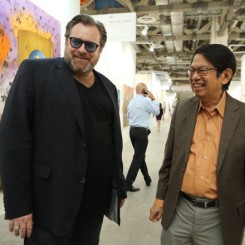The founder, co-owner and director of Art Stage Singapore, Lorenzo Rudolf is a veteran of art fairs—most notably, he served as the director of Art Basel from 1991 to 2000 and helped initiate Art Basel’s expansion to Miami (which started in 2002). In 2007, he launched SHContemporary, but for various reasons, left relatively quickly by 2009. His most recent venture, Art Stage Singapore, has established itself as the foremost art fair in Southeast Asia. Randian talked to Lorenzo Rudolf about his SHContemporary days and his observations of the Shanghai art scene. He also discussed the challenges (and potential) of operating in Singapore, and the reasons behind some of the curated exhibitions Art Stage has pushed in the fair.
Daniel Szehin Ho: You helped start SHContemporary back in the day. Perhaps we can start by reflecting a bit on that?
Lorenzo Rudolf: Now, look, I think when we first started the fair in Shanghai in 2007, there was something of a feeling that, now, Shanghai was starting. I remember very well when we were evaluating whether to do this show in Beijing or in Shanghai; in the end we decided on Shanghai because we were convinced on a long term basis that Shanghai was the right place—especially for an international market. But at that time, everything was speaking much more for Beijing—where the galleries were, where the artists were, etc. But I had this feeling there was this “mood” beginning towards Shanghai. Then, as we all know, we left the fair. Then I had the impression it was something like a bomb—it was the same time as the financial crisis when the bubble burst, and all these things came together. It meant that the market was one step from going away to Hong Kong. And there, from then on, for a couple of years Shanghai was like, dead.
And now in the last one or two years, you have the impression that a lot of things are changing. I can only speak as an outsider, but I think it has to do with how Shanghai seems to have carte blanche, a certain freedom to go somewhere—and they want to go somewhere. They facilitate things; they make it happen. It started with the private museums and so on, and now you even exaggerate—I think there’s three or five or seven fairs in three months! That cannot work, in the end. In the end, I think it will be validation for one or two fairs who want to position themselves.
I went over to the West Bund and was speaking with Zhou Tiehai. I must say, I was impressed. It was well-done. It was not only well-done in the way that it was beautifully built; there was a concept not to go too big—I think that makes sense. There’s a good balance between the international and the Chinese galleries. I was not so much impressed by the design; probably Tiehai had his thoughts about that. Nevertheless, I think it was a very, very good start for a fair in its first edition. If you see things like that, it shows there is confidence in Shanghai, and a confidence that is not only Shanghainese, but international.
I was at the opening of the Long Museum and the opening of the Budi Tek Museum. These are not small collector’s spaces, you know! They really show what they have! This is also going to take them into the steps of a public museum, and this is happening all over Asia.
You have to realize that you don’t have a lot of important, good public museums in Asia. Maybe you have one or two in Singapore, one or two in Korea or Japan—but the main museums in Asia are private ones. And in China, you have a new generation of collectors who have not only strong collections and rising international collections but also the money to build museums which also take over, in a certain way, the functions which public museums normally have. And having them in Shanghai—this accumulation and also this vision of the West Bund—I think in ten years, Shanghai will be a booming art city.
There’s just one point—one point, that’s the taxes. I think that if this situation is solved, Shanghai will explode.
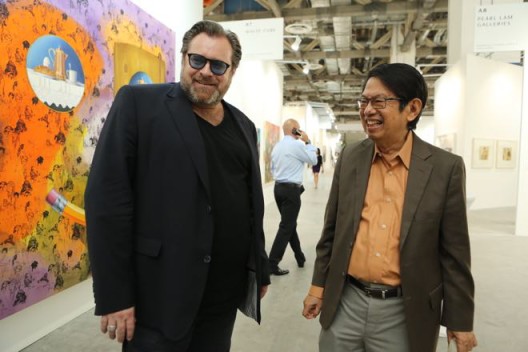
Art Stage Singapore 2014, Lorenzo Rudolf and Dr Oei Hong Djien
DH: I think there are the fairs, and there are the museums. Regardless of where the fairs go, the collectors are here building the museums.
LR: Recently I was in Seoul at a talk about how the market in Korea is down, and the fair finds it hard to sell. India at the moment is flat. China is functioning. What is the difference?
The big difference is the society, and how the market is functioning. For example in Korea, you have a market depending on five, six, seven very big buyers. If one of these six or seven buyers doesn’t buy—boom! In India, you have a society with a very, very small peak who are very, very rich, a small middle class, and a huge mass of the poor. In China, you don’t just have the Budi Teks, the Qiao Zhibings and the Wang Weis; you have a big middle class or upper middle class coming and beginning to buy.
DH: Are they? I know some of them are, but…
LR: It’s a start. It has to start somewhere. But if you see how society is moving, you have a pyramid with a middle class.
Yesterday I had a long talk with Tiehai. He said that what he sees—and I realize this—is that the buyers who buy most are middle-aged, 40-50, who work in international companies who make money, or who have their own fortunes, traveling, maybe has a university education from America—and that is what is coming. And that, exactly, is the upper-middle class.
Everywhere in the world, the market is strongest when you don’t only have a peak but a middle class behind it. It’s like a society—it can only work with a middle class. I think that that is exactly what is growing here, and it will make China the big market.
DH: I want to go back a little to SHContemporary. You probably saw something in China—the timing was a little off, perhaps.
LR: Yes and no. It was clear why I went to China. It was at this time that there was a Chinese boom. Everyone was talking about China and it was the right time to open the door there. We had the concept in the end, which was the double-step concept. We said we wanted to do a fair in Shanghai, and we also wanted to a second fair—not on the same dates, but under the same umbrella—in Hong Kong. One year would be the contemporary part, the next year would be the modern part. With that, we would lock Hong Kong; with that, Shanghai could grow. Our great partners, the Italians, with the job of locking it into Hong Kong, didn’t do that, and that was the reason why we left. But you see know what could have happened; it was right, the way of thinking.
Now, things have changed. Nevertheless, I think Shanghai is in a situation where it can grow. The only big advantages in Hong Kong? Advantage 1 is the taxes; advantage 2 is that it’s much easier to handle things there than in Mainland China. But those are things which can be changed, let’s be clear. On a long-term basis, I think Shanghai has a huge future. We have to be clear: you are a country which will be (in this century, for sure) increasingly the leading country economically with globalized tastes and a middle class bigger than that of any other country. These are all aspects that speak for a market.
DH: I think in China it’s always very hard for foreigners to operate—on so many levels. The connections, the guanxi, but also the language, getting to know the right people…I’m sure you’re familiar with many aspects of this.
LR: Let me put it this way. When you go somewhere, you have to adapt yourself. You cannot go and say “I know the only way to do things.” The most difficult part in China—there are the ones you mention—but what is more difficult is that you need a Chinese partner. That means you need a partner whom you can totally rely on. We are in a situation like this. Sometimes when you are in a very specific field like art fairs— especially at the time when we came—there was no partner who knew exactly what we do. That was much more the difficulty.
But then we had the luck—left and right and also with the people who advised us—to find the right way. You have to have an open respectful relationship, otherwise there will be friction. If someone goes wrong, the Chinese partner always wins. But I think that’s something you have to build up, and you know how in China if you want to do business, first you have to make friends. If you go to New York, you have to adapt to the rules of New York. It’s logical.
DH: Is there a level where it’s a bit more difficult in China than elsewhere?
LR: Sure. Why are Singapore and Hong Kong much easier? They have adapted much more to Western business conditions. It’s easier to do certain deals; you don’t always have to do things the Chinese way. But it doesn’t mean it’s better.
Back to what you’re saying about China. In the end, it’s not much more difficult if you know how to deal things the right way. Sure, there are certain stories in certain industries where you build things up a certain way and the Chinese take it over. You always have to be a) a step ahead, b) you also have to be very careful who your partners are, and c) what we do was so specific, it was not able to be taken over in this way.
Why did we leave? That was our own fault; not the fault of China. We had a lot of trouble at times, but the main fault was on our side. I think nowadays, more and more, China is adapting and opening themselves to operate with foreigners. In the end, if you want to reach something together, you have to both invest yourselves in it. That’s the only way that it functions.
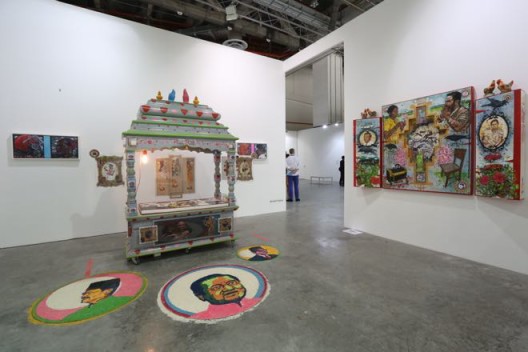
Art Stage Singapore, Southeast Asia Platform, Anurendra Jegadeva, Wei-Ling Gallery
DH: Let’s talk about Singapore. Has Singapore, for example, given a lot of support to ArtStage? What is the government doing well there in fostering the scene?
LR: The government has a vision. The government wants to position Singapore as one of the major hubs of contemporary culture and especially contemporary art in Asia and the world—surely in Southeast Asia—but they want much more. And they know that contemporary art has a huge financial impact, social impact and so on. That’s the reason they invest a lot of money. On the other side, they also need certain experts to do this. Singapore is a very small country. They’re building a huge new museum, the National Gallery, which will be the museum of the entire region, with the biggest collection of Southeast Asian contemporary art.
We are seen a bit as the catalyst of this entire movement. We open doors; we bring the people. After this fair started, after long discussions, we built an art district, Gillman Barracks. This is also where you see a bit how it works: they built it but they didn’t do it in the right way—and that’s the reason why it’s not functioning.
Singapore is at a stage where it still thinks it can build up a cultural place from the top down. That will not work. If art and culture are to prosper, first of all, they need freedom. You can realize the conditions in which you can grow, but you cannot do it yourself.
Singapore was built up in a very impressive manner from zero to become a top first-world destination. It was really built up in a way like a Lego tower; whatever you need, you put it on—brick by brick by brick. It’s really impressive to see what has been done. With this Lego tower, you have the hardware, but now the software must come. That’s exactly where we are, which means we are in a transition period; it also has to do with the change of generation.
Second, there have been, since then, two new museums, and a third one is opening. Okay, we can always discuss how not everything is always done in exactly the right way. You can learn, you can look, but things happen. In other words, the direction is right.
Yet Singapore is the center of an entire region which is also artistically booming. This has not only to do with the fair, surely, but also with the region itself—because this region from Indonesia to the Philippines is highly artistically developed. First of all, there is Indonesia with its artists, which has to do with its history. Now, the Philippines is coming, Malaysia is coming, and so on. What is lacking in the entire region is infrastructure. There are no museums. There are no foundations supporting art practice. Not many of the galleries are really competitive. All these things Singapore has. Singapore is in a certain way the hub for all these countries—it’s the only place which can be the center.
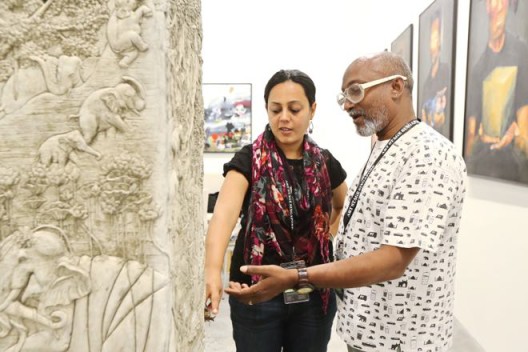
Art Stage Singapore 2014, India Platform curator Bose Krishnamachari and artist Sakshi Gupta
DH: There’s control in terms of freedom of speech and censorship. But I think you are also talking about funding programs and so forth.
LR: In terms of censorship: I think in the last five years we’ve had just two cases of censorship coming from the top down. It’s much more self-censorship. Certain things are not done because maybe it’s better not to do them.
If you come from the West with a tradition of I don’t know how many years of revolution and individualism, we cannot compare with this. Also in China!
DH: I think in China, there’s an idea that this control does not need to be given up—in fact, they look to Singapore as an example of a place with censorship that is top-level first world.
LR: Well, of course, the ruling class of Singapore is Chinese. But on the other hand, with global communications and the Internet, there are things you cannot turn back. The question is now how a society can handle that. It’s clear if you build up something like that in Singapore, where you look for every detail and responsibility for your citizens, you’re always a bit concerned that maybe it could get out of control.
It’s like parents with their kids. They all want the best for their kids—they want to educate them and guide them, but they also need to know that the kids want to go. The thing they can do for the kids is to make them independent.
DH: Well, but you know Chinese parents…
LR: [Laughs] You know what I mean…
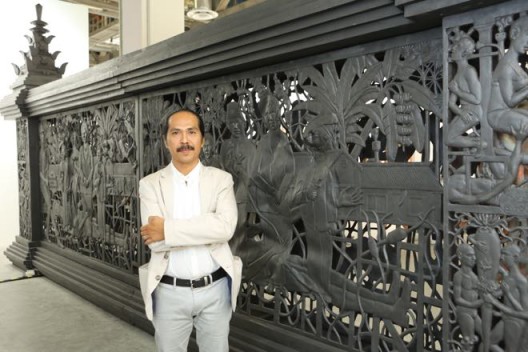
Art Stage Singapore 2014, Entang Wiharso, “Crush Me #2”, ARNDT
DH: So what happened with the Indonesian pavilion? Was there a bit of negative feedback?
LR: First of all, the situation is very simple. Indonesia has for many years been a huge market—with some top prices, some pieces having sold for over a million US dollars. Even at the auctions in Hong Kong, Indonesians were buying Indonesian artists. And this market functions quite well. Indonesia is so strong because artists have a very high position in society—it goes back to Sukarno and the revolution. His partners in the revolution were artists—many, many artists and intellectuals. Since then, in the upper and upper-middle classes, artists have a high standing, and that’s the reason why you have this huge market. You have hundreds of buyers; they organize themselves. There are even young collectors who are introduced by experienced collectors, and so on.
In Indonesia, you had a huge, huge market, but it was a domestic market. Collectors on one side and artists on the other dealt with each other in a beautiful way. They did not need galleries in between.
Now comes this situation of globalization: art fairs and so on. You now have these artists who realize—in Indonesia, they might be like rock stars with houses and Mercedes—that now they have the chance to go abroad. The problem? They don’t have the infrastructure to go out; they don’t have the galleries investing in them who want them to do that. So we were confronted with a very strange situation. More or less the entire artist scene approached us for help.
So we come to this typical situation concerning what we do in Asia, especially Southeast Asia, which is not comparable with doing a fair in Europe or America. Is our role to sell square meters to galleries and support galleries? Or is our role much more to support artists? So we were here to make a decision. If we were to help the artists, we would have a large number of the Indonesian galleries against us. If we say no, Indonesia remains where it is. In the end, we said we wanted to do it—with the galleries. Some joined, others did not. The result of all these discussions—the role of the art fair, the national thing about Singapore—it was a big success. It opened a lot of doors; a lot of these artists did big exhibitions in Western museums. Many were collected by Western museums—the Guggenheim began to buy, and the Tate, and so on. Those galleries who joined are successful; the others are still angry today.
But if Indonesia wants to work internationally, they need the galleries. Of course, it has been this way for many years, so it will take time to change. We have to discover artists ourselves and bring them into the market and the limelight. If you just continue like a classic fair in the West, first of all, there aren’t enough galleries, and the galleries are not paying. We have to find new business models, which is why we went in this direction.
DH: So the Indonesian pavilion will happen again?
LR: That was a one-off. But we thought the idea was right, so there will be a curated sales exhibition. There are a couple of advantages. First of all, you can really introduce and position the artists; you can’t do that with just one or two works in a gallery booth. We do it in a big pavilion for Southeast Asia. No national ghettoes: it’s Southeast Asia.
What we are doing here is not only to bring some galleries together but to introduce different parts of Asia to each other, and also to the West. This was why last year we made six or seven national pavilions beside the big Southeast Asian pavilion—China, India, Australia, Japan, Korea—and for each of the countries, we looked for one of the leading curators. They had a free hand to put together the pavilions; the only condition was behind that every artist, every project, every piece, there must be a gallery. That means it is for sale, and the gallery is on the other end. That worked very well. You had this funny thing where all the curators wanted to have a more successful pavilion and they called their collectors to come. It worked. But that was not the main goal: the main goal was to show and explain what it was.
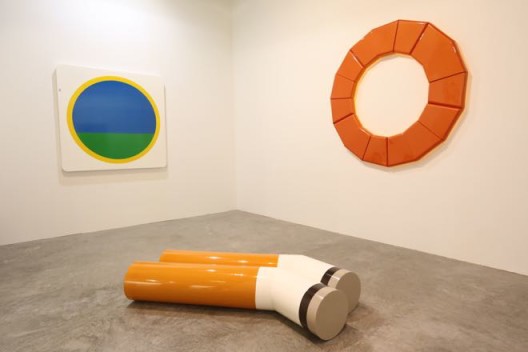
Art Stage Singapore 2014, “Nothing to Wait” For by Chun Kai Feng, FOST Gallery at SEA Platform
DH: So the curators had to choose from galleries that participated?
LR: No, they were free. They did not have to choose galleries that participated. The galleries could just participate with a piece or a project in the platform. Galleries could also suggest certain works to the curators.
DH: So who gets the cut?
LR: The gallery. The gallery is not buying for a booth; the gallery pays a participation fee. The participation fee covers, say, 60% of the cost; the other 40% was covered by sponsors.
DH: What about ArtJog? Is it a competition?
LR: That is no competition. ArtJog is really unique. Jogja is the big part of the Indonesian art world. If you go to Jogja (Yogyakarta), you have a strange situation: artists are like rock stars there. That’s their role; there’re no galleries around. Everything is in their hands—they even build their own exhibition centers where they show young artists. It’s very, very artist-driven. And ArtJog can only live due to this specific atmosphere. If you take this even to Bali or Jakarta, it will lose its entire flavor. Jogja is a bit of a nowhere-land—I mean, it’s not a major international city. It lives off this; that’s its charm.
DH: I think every year you are trying out different structures to display art.
LR: I’m not just thinking about different structures, but different realities. The other thing is that I think art fairs have to be more creative. Also, we are forced to think of new things. We always think of the competition of Hong Kong–Singapore. What is Art Basel Hong Kong? The biggest brand in the market. Like any big brand, it functions as a global brand. It’s like Gucci opening a store in Tokyo: it will also sell Gucci bags there.
We’re a small, young fair. We know we have to be a step ahead. Do something successful one year, and we might see it in Hong Kong the next year! We have to create new formats—and it’s also fun.
In 2015, we will see a curated exhibition with a theme; we don’t want to go along with national pavilions. Second, we want not just to think about the contemporary in Asia. The modern in Asia is very much connected with what was happening in the West. But if you look at India, China, Indonesia and Japan and so on, you see works in parallel. You may be able to see how they are more or less about the same roots — but happened independently. We want to open the doors step by step to modern Asian art.
And with the 50th anniversary of Singapore, there will be a big get-together. Lots of people and artists and galleries. It should be a big celebration as well.

Art Stage Singapore 2014, Public talk with Entang Wiharso, Lorenzo Rudolf, Uli Sigg, moderated by Gea Politi
DH: There’s quite a trend for fairs to be smaller. Are we sick of the big monster fair?
LR: I think we are. Of course, Art Basel can only be a monster fair; that’s the principle of it. But if you have one like Art Basel, all the other ones will already not be competitive. And there cannot be global monster fairs in every international city.
If people travel around—for example, if I travel to Shanghai, I don’t want to see what galleries in Berlin are doing. But maybe as a Chinese person going to a fair in China, I want to see some select, great things from the West. I think you must find the right balance. And it depends on the place.
I think there is a real pride in Asia—which is absolutely right. Asia respected and seen on the same level, and not just a cherry on the cake of an international fair. Asia in the end needs an Asian Basel—a fair that is as professional as Basel, as important as Basel, but with an Asian background. I mean, you see with Art Basel Hong Kong: you might have 50% Western and 50% Asian, but if the Western galleries have a booth three times the size of the Asian galleries, the impression is different. I mean, it’s difficult.
And I have to defend Basel a bit. You can’t forget that they have hundreds of galleries behind them who push them to open the door to Asia. Can they say “no” to everybody? It’s not so easy.
I think Asians want to be respected, and that that will happen more and more. And there will be a point where Asians and top Asian collectors will want to position, like Western collectors, their Asian artists on the world market. When that happens, the balance will change.
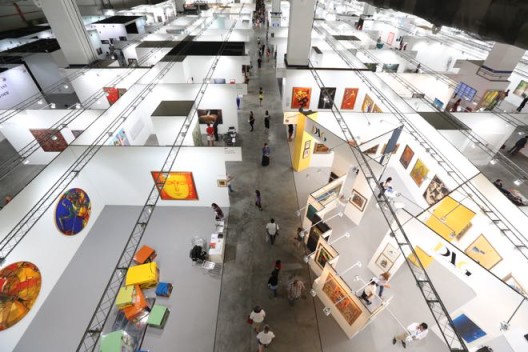
Art Stage Singapore 2014
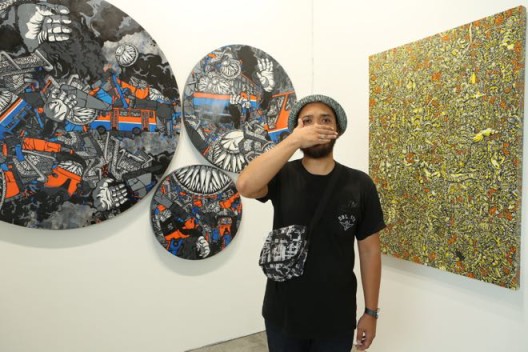
Art Stage Singapore 2014, artist Darbotz at Mizuma Gallery
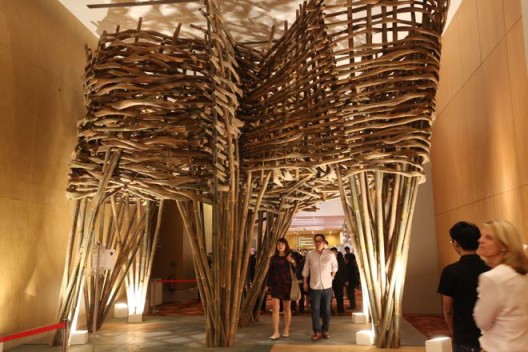
Art Stage Singapore 2014, entrance arch, “The Continuous Gate” by Joko Dwi Avianto
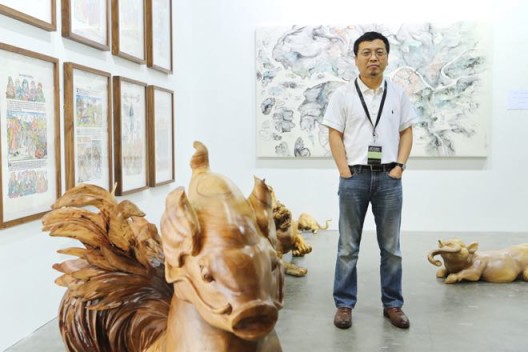
Art Stage Singapore 2014, China Platform Curator Huang Du
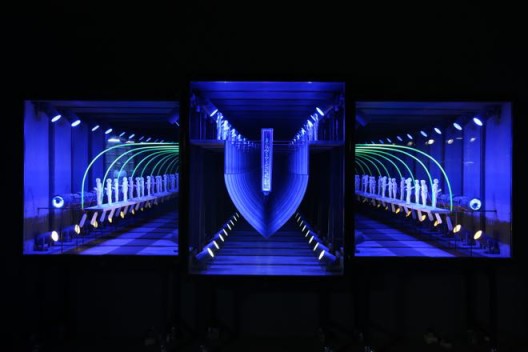
Art Stage Singapore 2014, Southeast Asia Platform, Mark Justiniani at The Drawing Room

